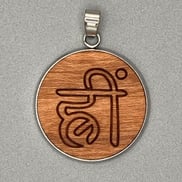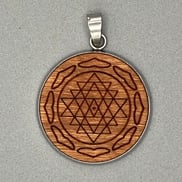Sanatana Dharma


AUM
The Hindu syllable "Aum" (spelled "Om" as “AU” becomes “O” in Sanskrit) is a sacred sound and symbol that represents the essence of the ultimate reality, or the universe itself. It is considered the primal sound from which all existence emanates. In Hindu philosophy, "Aum" embodies the divine, transcending all forms of language and thought. The syllable is composed of three letters: "A," "U," and "M." The "A" represents creation, the beginning, and the waking state. The "U" signifies preservation, the maintenance of existence, and the dream state. The "M" symbolizes destruction, dissolution, and the deep sleep state. Together, they represent the cycle of birth, life, death, and rebirth, encapsulating the entire universe's rhythm. "Aum" is also linked to the concept of Brahman, the supreme consciousness, and is frequently used in meditation and spiritual practices to connect with the divine. The sound is thought to bring harmony and peace, aligning the individual with the cosmic forces. As a symbol, "Aum" is not only central to Hinduism but also resonates deeply in Buddhism, Jainism, and other Eastern traditions.


Durga Yantra
The Durga Yantra is a sacred geometric diagram in Hindu culture, symbolizing the divine energy and protective power of Goddess Durga. It is used as a spiritual tool for meditation, worship, and invoking the goddess’s strength, courage, and victory over negative forces. The yantra consists of interlocking triangles, lotus petals, and a central point called the bindu, which represents the source of divine feminine power (Shakti). Each element of the Durga Yantra holds symbolic meaning. The upward and downward triangles represent the union of male and female energies, while the lotus petals signify purity, spiritual awakening, and cosmic harmony. At its center, the bindu is the focal point for concentration and divine presence. Used in rituals, the Durga Yantra helps devotees focus their minds, remove obstacles, and draw in the goddess’s fierce yet nurturing energy. It is especially worshipped during Navaratri, the nine nights dedicated to the goddess. Spiritually, it reminds practitioners of the power of inner strength, the destruction of evil, and the triumph of divine truth. The Durga Yantra serves as both a spiritual map and a protective shield in the journey toward enlightenment.


Gayatri Yantra
The Gayatri Yantra is a sacred geometric diagram in Hindu culture, representing the divine energy of the Gayatri Devi, the goddess of wisdom, purity, and enlightenment. It is closely associated with the Gayatri Mantra, one of the most powerful and revered Vedic chants dedicated to the sun deity (Savitr), symbolizing the source of all life and knowledge. The yantra itself is a complex arrangement of interlocking triangles, circles, and lotus petals, each element embodying cosmic truths and spiritual energies. The upward and downward triangles represent the union of the masculine (Shiva) and feminine (Shakti) energies, while the central point (bindu) signifies the source of creation and divine consciousness. Used for meditation and spiritual rituals, the Gayatri Yantra serves as a visual aid to focus the mind, purify thoughts, and connect with higher realms of awareness. It is believed to bring clarity, intelligence, and protection to those who meditate upon it with devotion. Often placed in homes or temples, the yantra acts as a channel for divine blessings and is a reminder of the soul’s journey toward truth and inner light. In essence, it encapsulates the sacred geometry of the universe and the spiritual essence of the Gayatri Mantra.


HRIM
In Hinduism, the syllable HRIM (pronounced "hreem") is a powerful bija mantra, or seed syllable, deeply rooted in Tantric and Vedic traditions. It is associated with the goddess Mahadevi or Shakti, the divine feminine energy, particularly in her aspects as Parvati, Durga, and Lalita Tripura Sundari. HRIM is considered the Shakti Bija—the sound of divine creative force. This syllable embodies both maya (illusion or creative power) and moksha (liberation), symbolizing the ability to both bind and liberate the soul. It is used to purify the mind and heart, and to awaken higher consciousness. HRIM is said to resonate with the heart chakra (Anahata), fostering love, compassion, and inner transformation.In tantric practices, chanting HRIM helps in invoking the goddess and accessing her grace. It is also believed to break through ego and illusion, guiding the practitioner toward self-realization. HRIM is often found in longer mantras and is revered for its spiritual potency, subtle vibrations, and transformative effects on both the mental and spiritual planes. Its sound encapsulates divine energy, making it a key element in spiritual disciplines such as meditation, mantra yoga, and ritual worship.


Kali Yantra
The Kali Yantra is a powerful geometric symbol in Hindu culture, representing the fierce and transformative energy of Goddess Kali, the embodiment of time, death, and spiritual liberation. This sacred diagram is used for worship, meditation, and protection, helping devotees connect with Kali’s divine force to overcome fear, ego, and attachment. The yantra typically consists of interlocking triangles, lotus petals, circles, and a central bindu (dot). The downward-pointing triangles symbolize the feminine energy (Shakti), and the bindu represents the cosmic source or ultimate reality. The eight-petaled lotus often found in the yantra signifies the dynamic aspects of creation and destruction. The outer square with gates serves as a protective boundary. Goddess Kali is known for her role in destroying ignorance and illusion, making the Kali Yantra a symbol of inner purification and transformation. Practitioners use it to invoke courage, clarity, and the power to face life’s deepest challenges. Spiritually, the Kali Yantra helps transcend the limitations of the ego and time, guiding the devotee toward moksha (liberation). It is especially revered in Tantric practices, where it serves as a visual tool for aligning with the raw, unfiltered power of the divine feminine.


Lotus
In Hindu culture, the lotus holds deep symbolic significance and is revered as a sacred flower. It represents purity, spiritual enlightenment, and divine beauty. Despite growing in muddy waters, the lotus remains unstained, symbolizing the ability of the soul to rise above worldly attachments and material desires. This quality makes it a powerful metaphor for spiritual growth and the journey toward liberation (moksha). The lotus is often associated with several Hindu deities. Goddess Lakshmi, the goddess of wealth and prosperity, is frequently depicted seated on a blooming lotus, signifying spiritual and material abundance. Lord Vishnu, the preserver of the universe, is also shown holding a lotus, emphasizing order, balance, and life-giving energy. Similarly, Lord Brahma, the creator, is believed to have emerged from a lotus that sprouted from Vishnu’s navel, symbolizing creation and the unfolding of the universe. In Hindu scriptures, the lotus is also linked to chakras, particularly the crown chakra (Sahasrara), which represents supreme consciousness. Overall, the lotus embodies detachment, inner strength, and the eternal pursuit of truth.


Shri Yantra
The Shri Yantra, also known as the Sri Chakra, is a sacred geometric symbol used in Hinduism and in various forms of spiritual practices. It is considered one of the most powerful and auspicious yantras (sacred diagrams) for meditation and worship. The Shri Yantra consists of nine interlocking triangles arranged in a specific pattern that radiates from a central point known as the bindu. These triangles are said to represent the various aspects of the divine, with some symbolizing the masculine and feminine principles, and others representing the material and spiritual worlds. The Shri Yantra is often associated with the goddess Tripura Sundari, a form of the Divine Mother, and is believed to represent the cosmic universe and the divine energy of creation. Its structure is said to help achieve balance, peace, and prosperity. In meditation, practitioners focus on the bindu and the surrounding patterns, believing that it helps awaken higher consciousness and brings spiritual enlightenment. Many consider the Shri Yantra a symbol of ultimate truth and a tool for manifesting positive energy and spiritual growth, making it highly revered in tantric and spiritual traditions.


Trishula
The Trishula is a powerful and ancient symbol in Hindu culture, representing a trident with three prongs. It is most commonly associated with Lord Shiva, one of the principal deities in Hinduism. Each prong of the Trishula holds deep symbolic meaning, often interpreted as representing the three aspects of existence: creation (Brahma), preservation (Vishnu), and destruction (Shiva). This reflects the Hindu belief in the cyclical nature of the universe. The three points also symbolize the three gunas—sattva (balance), rajas (activity), and tamas (inertia)—which govern all matter and life in the cosmos. Alternatively, they are seen as representations of past, present, and future, indicating Lord Shiva’s dominion over time. In yogic philosophy, the Trishula can also be viewed as symbolizing the three main energy channels (nadis) in the body: ida, pingala, and sushumna, which must be balanced for spiritual awakening. Beyond its symbolic meanings, the Trishula is also a weapon, signifying the power to destroy ignorance and illusion. It reminds devotees of the deeper truths of life and the importance of transcending duality to reach a state of unity and enlightenment.
